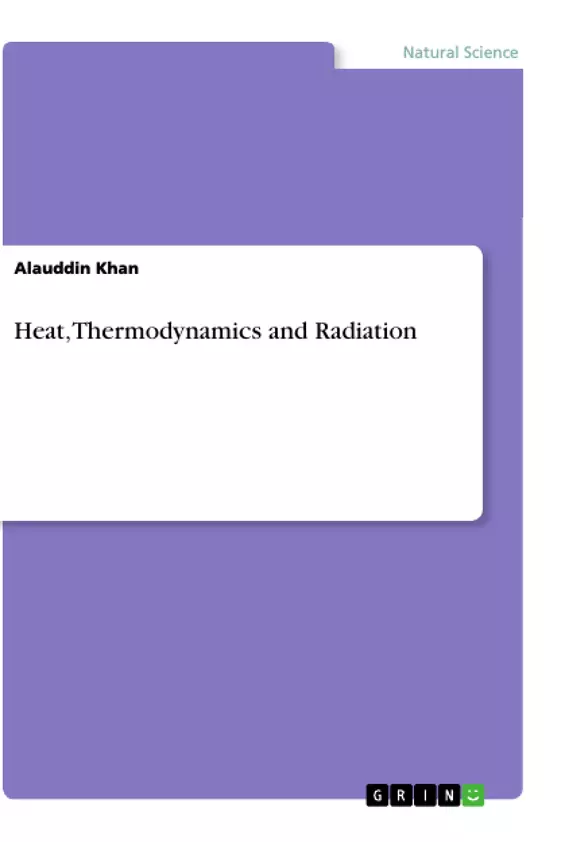The book consists of thirteen chapters to fulfill requirements of different kind of readers. This volume takes into account the study of Thermometry, Kinetic theory of gases, the equation of state, The change of state, Transmission of heat, First law of Thermodynamics, Thermodynamic functions, Second law of Thermodynamics, Third law of Thermodynamics, Maxwell's equation, Clausius–Clapeyron equation and Radiation Laws. The volume contains illustrative examples of both the ideas and the methods. The book is intended as a text book on Heat, Thermodynamics and Radiation for undergraduate levels and also as a reference book for anyone who is interested in this field of enquiry. The book is comprehensive enough to cover all the topics that are usually taught to upper-undergraduate students of Physics, Chemistry and Engineering. This book will be useful to students and teachers in different universities around the world.
Inhaltsverzeichnis (Table of Contents)
- Thermometry
- Kinetic theory of gases
- Equations of State
- Change of State
- Transmission of heat
- First law of Thermodynamics
- Thermodynamic functions
- Second law of Thermodynamics
- Third Law of Thermodynamics
- Heat Engine
- Carnot's Theorem and Carnot's Cycle
- Maxwell's equation
- Clausius-Clapeyron equation
- Radiation Laws
Zielsetzung und Themenschwerpunkte (Objectives and Key Themes)
This textbook, designed for undergraduate students in engineering, pure and applied sciences, aims to provide a comprehensive understanding of Heat, Thermodynamics and Radiation. It aims to serve as a reference for those interested in this field of inquiry. The text covers the fundamental principles and methods of this subject area, employing both large-scale thermal phenomena and less accessible small-scale phenomena to explain the concepts.
- Thermodynamic principles and methods
- Kinetic theory of gases
- Heat transfer and its mechanisms
- Laws of Thermodynamics and their applications
- Radiation laws and their significance
Zusammenfassung der Kapitel (Chapter Summaries)
- Chapter-1 Thermometry: This chapter delves into the fundamentals of thermometry, exploring different methods for measuring temperature and their applications.
- Chapter-2 Kinetic theory of gases: This chapter examines the kinetic theory of gases, focusing on the behavior of gas molecules at the microscopic level and their relationship to macroscopic properties like temperature and pressure.
- Chapter-3 Equations of State: This chapter introduces the concept of equations of state, which describe the relationships between various thermodynamic variables, such as pressure, volume, and temperature, for different substances.
- Chapter-4 Change of State: This chapter explores the different phases of matter and the transformations between them, including melting, freezing, boiling, and condensation, focusing on the underlying thermodynamic principles involved.
- Chapter-5 Transmission of heat: This chapter examines various methods of heat transfer, including conduction, convection, and radiation, outlining the mechanisms and factors that affect heat transfer rates.
- Chapter-6 First law of Thermodynamics: This chapter delves into the first law of thermodynamics, focusing on the conservation of energy and its implications for thermodynamic processes.
- Chapter-7 Thermodynamic functions: This chapter introduces various thermodynamic functions, such as enthalpy, entropy, and Gibbs free energy, and their applications in describing the state of thermodynamic systems.
- Chapter-8 Second law of Thermodynamics: This chapter examines the second law of thermodynamics, focusing on the concept of entropy and its implications for the direction of spontaneous processes.
- Chapter-9 Third Law of Thermodynamics: This chapter discusses the third law of thermodynamics, which deals with the behavior of systems at absolute zero temperature.
- Chapter-10 Heat Engine [Carnot's Theorem and Carnot's Cycle]: This chapter explores the concept of heat engines and their efficiency, focusing on Carnot's theorem and the Carnot cycle, which define the theoretical limit for engine efficiency.
- Chapter-11 Maxwell's equation: This chapter introduces Maxwell's equations, which describe the behavior of electromagnetic fields, and their relationship to thermal radiation.
- Chapter-12 Clausius-Clapeyron equation: This chapter examines the Clausius-Clapeyron equation, which relates the vapor pressure of a liquid to its temperature, and its implications for phase transitions.
Schlüsselwörter (Keywords)
This textbook delves into key topics like thermometry, kinetic theory of gases, equations of state, heat transfer, laws of thermodynamics, and radiation laws, utilizing concepts such as enthalpy, entropy, Gibbs free energy, and Carnot's theorem to provide a thorough understanding of heat, thermodynamics, and radiation. The text emphasizes both theoretical principles and practical applications within the realm of thermodynamics and its impact on various phenomena.
- Arbeit zitieren
- Alauddin Khan (Autor:in), 2020, Heat, Thermodynamics and Radiation, München, GRIN Verlag, https://www.grin.com/document/967942



